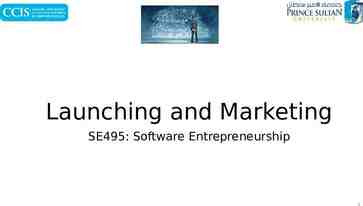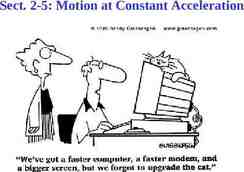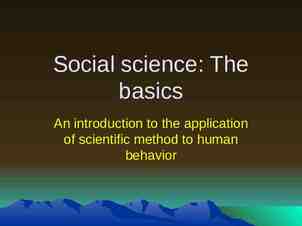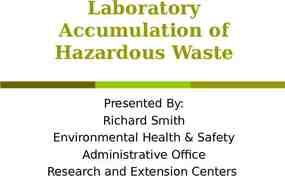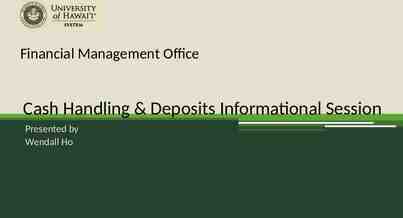CS 620 Introduction to Information Security Dr. Karen
51 Slides807.00 KB

CS 620 Introduction to Information Security Dr. Karen Forcht Department of Computer Science James Madison University

Part I (Overview, Access, Control, Cryptography, Risk Analysis) Part II (Business Continuity Planning, Data Classification, Security Awareness, Computer and System Security)

Part III (Telecommunications Security, Organization Architecture, Legal Regulatory Investigation) Part IV (Investigation, Application program Security, Physical Security, Operations Security)

Part V (Information Ethics, Policy Development)

Computer Security Act of 1987 Requires: Sensitive systems and data must be identified Plans for ensuring security and control of such systems must be created Personnel training programs must be developed and in place

Development of Security Program Objectives Policies Connectivity, Corporate Structure, and Security Plans Responsibilities

Security Policy Goals Avoidance Deterrence Detection Correction

Risk Analysis Identify sensitivity of data Determine value of systems and information Assess threats and vulnerabilities (sabotage, environment, errors)

Purposes of Risk Analysis No significant intentional or accidental threat is overlooked Assure that cost-benefit analysis is reasonable

Contingency Plan Purpose: Protect, detect, recover Criticality: Formulated, communicated to ALL employees, tested regularly

Legal Issues Licenses Fraud/Misuse Privacy Copyright Trade Secrets Employee Agreements

Access Control Collection of mechanisms to restrain or prohibit use of information and systems Includes: Functions, implementation, good practices, environmental constraints

Considerations Ownership of Data Custodian of Data Accountability Reconciliation Rule of Least Privilege

User Authentication and Password Management Access Control Knowledge-Based Authentication Token-Based Authentication Characteristic-Based Authentication Password Management

Access Control Policies Procedures Standards Control

Cryptography Definition: Use of secret codes to provide integrity/confidentiality of information during transfer and storage Considerations: -Complexity -Secrecy - Characteristics of key

Definition: Encryption: plaintext to ciphertext Decryption: From ciphertext to plaintext

Key Management Public vs. Private Selecting Key Management of the Keys Protection of Keys Testing of Keys Updating Keys Error Detection

Risk Management Includes ideas, models, methods, techniques to control risk Includes: -Assessment -Reduction -Protective measures -Risk Acceptance -Insurance

Considerations of Risk Assessment Annual Loss Expectancy(ALE) Asset Valuation/Inventory Types of Attacks/Threats Availability of Resources/Denial of Service Detection Exposure Passive Threats Perils Prevention Analysis/Assessment/Management of Risk Data Valuation

Classification of People/Assets Should Include: -People -Procedures -Data/Information -Software -Hardware

Threat and Exposure Assessment Density/Volume of Information Accessibility of Systems Complexity Electronic Vulnerability Media Vulnerability Human Factors

Safeguards and Counter Measures Prevent Exposures Detect Attempted Threats Correct the Causes of Threats

Business Continuity Planning (1) Planning and Analysis Methods Rates of Occurrence of Disabling Events Availability and Use of Planning Tools/Aids Identification of Business Success factors(BSF) and Critical capabilities(Critical or Key Success Factors (CSF/KSF)

Business Continuity Planning (2) Alternative Sources of Supply Legal and Regulatory Requirements

Backups and Procedures Importance for Recovery Data Value Manuals and Documentation Back Up Frequency On-Line Systems Equipment

The Three C’s -Catastrophe -Contingency -Continuation BE PREPARED!!!

Off-site Backups and Storage Two Control Points: 1. When backup material is being transferred to/from the site 2. When backup material is stored at the site (also consider in-house storage)

Data Classification Elements and Objectives of a Classification Scheme Criteria used to Classify Data Procedures to be Used Differences Between Government and Commercial Programs Limitations Program Implementation

To Be Included: Distinguish Between Classification and Sensitivity Classified vs. Sensitive Data Elements Handling of Data Identify Criteria Classification Schemes Rule of Users Managers Effect of Data Aggregation on Classification Techniques for Avoiding Disclosure

Security Awareness Include: Corporate Policies, Procedures, Intentions Areas Where Remedial Actions are Needed Assessment of Threats and Vulnerabilities Technology Trends Behaviors to be Encouraged User Motives Applicable Laws and Regulation Available/Applicable Communication Channels/Media

Administrative/Organizational Controls Policies Awareness Employee Non-Disclosure Considerations Employee Training Telecommuting Considerations Effects of Technological Changes/Updates

Personnel Considerations Human Motives for Criminal Action Employee Selection Professional Certificates Working Environment Technological Updates (Effect on Users) Employee Separation

Computer and System Security Professionals Should Understand: Computer Organizations, Architectures, Designs Source and Origin of Security Requirements Advantages/Disadvantages of Various Architectures Security Features/Functions of Various Components Choices to be Considered When Selecting Components

Common Flaws and Penetration Methods Operating Systems Flaws Penetration Techniques(Trojan Horses, Virus, Salami Attack, Deception)

Viruses Design Protection Recovery Prevention Counter Measures

Telecommunications Security Objectives hazards and Exposures Effects of Topology, Media, Protocols, Switching Hazards and Classes of Attack Defenses and Protective Measures

Methods Aborted Connection Active Wiretapping Between - The - Lines Entry Call Back Emanations Covert Channel Cross-Talk Eavesdropping Electronic Funds Transfer(EFT) Handshaking

Considerations Transmission Technologies Bandwidth Connectivity Potential Geographical Scope Noise Immunity Security Applications Relative Cost

System Security Officer Organizational Knowledge (Structural and Behavioral) Technical Knowledge Accounting/Audit Concepts Personnel Administration Matters Laws/Legislation Strategic/Tactical Planning Labor/Negotiation/Strategies/Tactics

Computer Security Incidence Response Goals Constituency Structure Management Support/Funding Charter Handbook of Operations Staffing

Legal/Regulatory Federal Laws/Regulations State Laws/Regulations International Issues Organizational/Agency Considerations Personal Behavior Remedies to Constituents Civil vs. Criminal Law Pending Legislation

Computer Crime Fraud Embezzlement Unauthorized Access “White Collar” Crime Theft of Hardware/Copying Software Physical Abuse Misuse of Information Privacy/Confidentiality Violations Intellectual Property Negligence License Agreements

Investigation Legal Requirements for Maintaining a Trail of Evidence Interrogation Techniques Legal Limits on Interrogation Methods Permitted

Application Program Security Distribution of Controls Between Application and System Controls Specific to Key, Common, or Industry Applications Criteria for Selection and Application Tests for Adequacy Standards for Good Practice

Software Controls Development Maintenance Assurance Specification and Verification Database Security Controls Accounting/Auditing

Physical Security Site/Building Location External characteristics/Appearance Location of Computer Centers Construction Standards Electrical Power(UPS) Water/Fire Considerations Traffic/Access Control Air Conditioning/Exhaust Entrances/Exits Furnishings Storage of Media/Supplies

Operations Security Resources to be Protected Privileges to be Restricted Available Control Mechanisms Potential for Abuse of Access Appropriateness of Controls Acceptable Norms of Good Practice

Information Ethics Doing the Right Thing!! Privacy/Confidentiality Common Good Professional Societies Professional Certifications

Policy Development Considerations: Have Longevity Be Jargon Free Be Independent of Jobs, Titles, or Positions Set Objectives Fix Responsibility Provide Resources Allocate Staff Be Implemented Using Standards and Guidelines

That’s All Folks (and not a minute too soon!!) I’m Looking Forward to working With You!!!!

